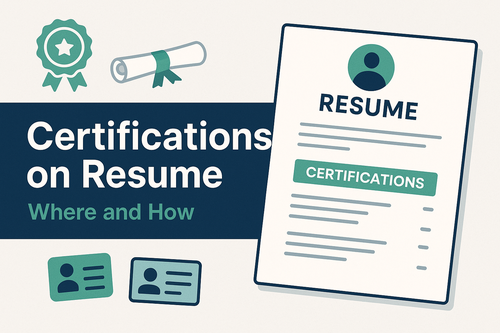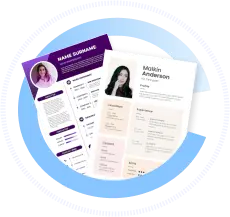Certifications & Licenses on a Resume: Where and How
Certifications on resume play a vital role in showcasing your professional qualifications, especially in regulated or technical fields. Properly listing and positioning certifications and licenses can boost your ATS score and impress hiring managers in 2025.
| What to Do (Short Checklist) |
|---|
| Include certifications relevant to your target job |
| List certifications in a dedicated section |
| Provide certification name, issuing organization, and date earned |
| Highlight certifications with industry recognition |
| Customize certifications based on the job description |
Who This Guide Is For
This guide assists professionals across all experience levels, particularly in technical, regulated, and specialized industries such as IT, healthcare, finance, and engineering. Whether you’re adding certifications for the first time or updating your resume, these tips and examples help maximize impact.
Certifications & Licenses on a Resume — Definition & Purpose
Certifications and licenses prove your competency and compliance with industry standards, often essential for certain roles. Displaying them clearly on your resume signals credibility and readiness for specific job requirements.
Best-Practice Rules (Do / Don’t)
| Do | Don’t |
|---|---|
| Create a separate “Certifications” or “Licenses” section | List outdated or irrelevant certifications |
| Use official certification titles and abbreviations | Use vague terms or omit issuing organizations |
| Include expiration or renewal dates if applicable | Overcrowd section with non-pertinent credentials |
| Order certifications by relevance or recency | Place certifications randomly within work history |
Examples by Level & Industry
IT Professional
- Certified Information Systems Security Professional (CISSP), ISC2, 2024
- AWS Certified Solutions Architect, Amazon Web Services, 2023
Healthcare
- Registered Nurse (RN), State License #12345678, Expires 2026
- CPR and First Aid Certification, American Red Cross, 2025
Finance
- Chartered Financial Analyst (CFA) Level II Candidate
- Certified Public Accountant (CPA), California Board of Accountancy, 2024
Project Management
- Project Management Professional (PMP), PMI, 2024
- Agile Certified Practitioner (ACP), PMI, 2025
How to Customize Certifications to a Job Description
- Identify certifications the employer prioritizes or requires.
- Highlight certifications that set you apart or match role demands.
- Include supporting certifications relevant to industry trends.
- Remove or de-emphasize expired or unrelated credentials.
Formatting Tips (ATS + Readability)
- Use a clear header like “Certifications” or “Licenses.”
- List each certification on a separate line for clarity.
- Include the full certification name, certifying body, and date.
- Avoid abbreviations without explanation, especially lesser-known certs.
- Maintain a simple font and layout consistent with the rest of your resume.
Checklist & Templates
| Certifications Section Checklist |
|---|
| Is the section clearly labeled and easy to find? |
| Are certification names and issuing bodies correct? |
| Are dates included when relevant? |
| Is the list tailored for the job application? |
| Is formatting consistent and ATS-friendly? |
Fill-in-the-Blank Template:
“[Certification Name], [Issuing Organization], [Year Earned or Expiration Date]”
FAQ
Q: Where should certifications be placed on a resume?
A: Preferably in a dedicated “Certifications” or “Licenses” section, usually after education or skills.
Q: Should I include expired certifications?
A: Generally no, unless the certification is considered lifetime or very relevant.
Q: How do I list certifications that are in progress?
A: Use “In progress” or “Expected [month/year]” next to the certification name.
Q: Can certifications help me get past ATS?
A: Yes, certifications often contain keywords scanned by ATS and validate your qualifications.


